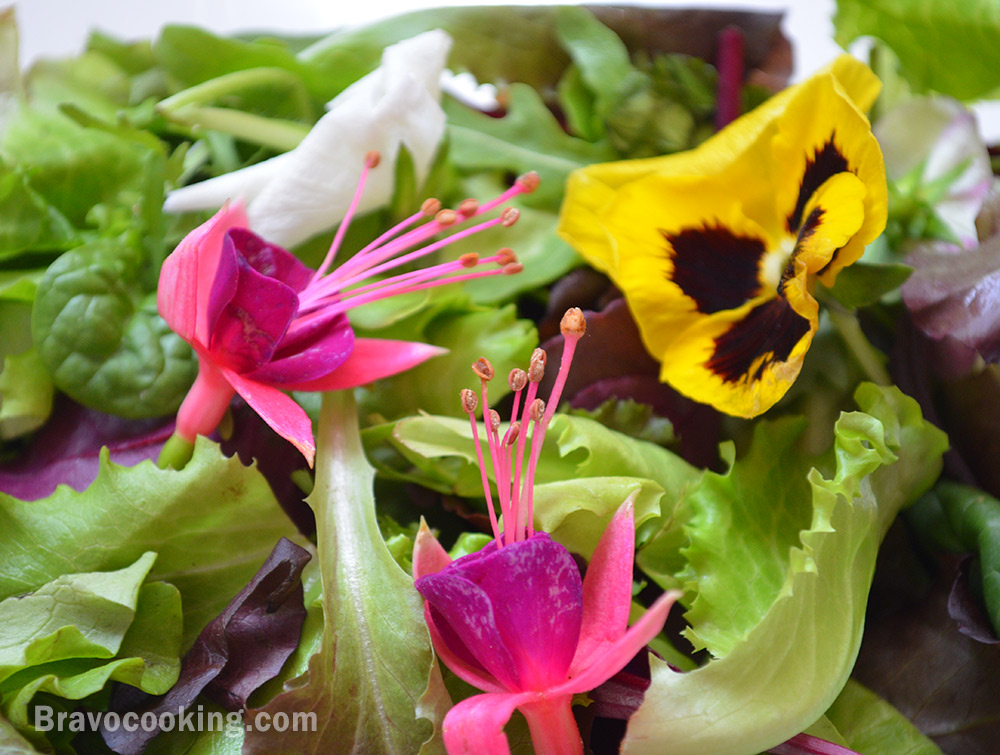Edible Flowers
General uses for edible flowers: as an edible garnish or decoration of salads, desserts and drinks; adding colour and flavour.
Although many flowers are edible, as some are poisonous, it’s best to stick to the one’s you know are ok and to that end, we have included a chart below listing the safe ones. In general, the flowers of vegetables and herbs are safe to eat.

Ten Rules of Edible Flowers
- Eat flowers only when you are positive they are edible.
- Just because a flower is served with food does not mean it is edible.
- Eat only flowers that have been grown organically.
- Do not eat flowers from florist, nurseries, or garden centers.
- If you have hay fever allergies, do not eat flowers.
- Do not eat flowers picked from the side of the road. They are contaminated from car emissions.
- Remove pistils & stamens from flowers before eating. Eat only the petals.
- Not all flowers are edible. Some are poisonous.
- There are many varieties of any flower. Flowers taste different when grown in different locations.
- Introduce flowers into your diet in small quantities
Here a list of some edible flowers and some flowers to avoid eating:
List of some edible flowers:
Anise hyssop
Arugula blossoms
Basil blossoms
Bee Balm blossoms
Borage
Chrysanthemum
Dandelion
Dianthus
Dill blossoms
Garlic Chive Blossoms
Hibiscus
Hollyhock
Lavender
Lilac
Pineapple Sage
Sage blossoms [garden sage/Salvia officinalis]
Scarlet Runner Bean flowers
Sunflower petals
Tulip
Violets
List of some toxic flowers:
Anemone
Azalea
Buttercup
Calla lily
Daffodil
Four o’clock
Hyacinth
Iris
Lily of the valley
Morning Glory
Oleander
Poinsettia
Sweet Pea
Wisteria
How to buy or harvest, prepare and store flowers for eating
Buying Flowers for cooking
Unfortunately it’s impossible to tell whether ordinary cut flowers bought from florists (who can supply flowers by post), and other outlets have been sprayed with chemicals. Most likely they have been, so it’s best not to use them for culinary purposes. However, if you can’t grow your own, help is at hand as there are companies on the internet who sell flower petals specifically for use in cooking. Just search for “buy edible flowers”.
Harvesting, preparing and storing flowers
It’s best to pick flowers just before you want to use them and when they are just opened, then wash carefully in cold water. Adding a little salt to the water will help get rid of any insects. Once well washed, carefully pat dry on kitchen paper or allow them dry naturally at room temperature. They can then be stored in the refrigerator in a plastic bag until ready to use but preferably not longer than 3 days.
In general the petals are the edible part of flowers, not the centre of the flower so you should detach the petals and cut off the white ‘heel’ at their bases as this tends to be bitter. The pistil and stamen should also be removed, especially from larger flowers.
Do not pull the petals off until you are ready to use them. Exceptions to this are large flowers which are going to be stuffed such as courgette flowers, and smaller flowers such as violas which can be eaten whole.
Once naturally dry, edible flowers can also can be fully dried or frozen, although the texture will change, so they are best used for infusions or in cooked dishes.
Types of edible flowers
- Arugula – See rocket
- Citrus Flowers (orange, lemon, lime, grapefruit). Use sparingly for a citrus flavour.
- Courgette – see Squash
- Day Lilies (Hemerocallis) – Slightly sweet flavour. Suitable for desserts and for stuffing or deep frying. NB: Do not eat other types of lilies (Lillium) as they are poisonous . If in doubt – leave it out.
- Gladiolus – Very bland flavour. Suitable for sweet and savoury stuffings (remove the anthers) and individual petals in salads.
- Lilac – Highly floral, slightly bitter lemony flavour. Suitable for salads.
- Marjoram – Milder flavour than the herb, use as the herb.
- Rocket – Also known as Arugla. Taste similar to the leaves so can be used in the same way especially in salads.
- Rosemary – Milder version of the herb. Use as the herb especially good with meats and seafood.
- Roses – All roses are edible. The flavours depends on type and colour, but generally fruity.
- Squash – Courgette flowers are excellent when stuffed as are gladioli and day lily (Hemerocallis) flowers, although the latter two are used more for their look rather than taste. Courgette flowers are also excellent batter and deep fried. N.B.: If you grow your own, try using the male flowers first so it doesn’t interfere with your vegetable cropping. Pick before fully opened.
- Sunflower – Bitter-sweet flavour. Use like chrysanthemums. Can also be picked before the flower bud opens and steamed when they are reminiscent of artichokes.
Precautions
- People who suffer from allergies should be on alert for possible allergic reaction. Only eat a very small amount initially.
- Avoid using flowers picked from the roadside as these may have been sprayed subjected to high carbon monoxide levels.
- Do not use lilies from the Lillium family as these are poisonous.
